University Report: Key Issues of Australian Aboriginal Population
VerifiedAdded on 2020/05/16
|7
|1033
|58
Report
AI Summary
This report provides an overview of the significant issues impacting the Australian Aboriginal population. It highlights disparities in life expectancy, infant mortality rates, and educational attainment compared to non-Aboriginal Australians. The report examines the historical context of colonization and its impact on Aboriginal rights, health, and living standards. It references key legislation like the Aboriginal Affairs Act and international declarations such as the UN Declaration on the Rights of Indigenous Peoples and the Universal Declaration of Human Rights, which aim to safeguard and improve the well-being of Aboriginal communities. The analysis includes statistical data, population pyramids, and figures illustrating death rates by cause, emphasizing the need for ongoing efforts to address these challenges and bridge the gaps in social and health outcomes.
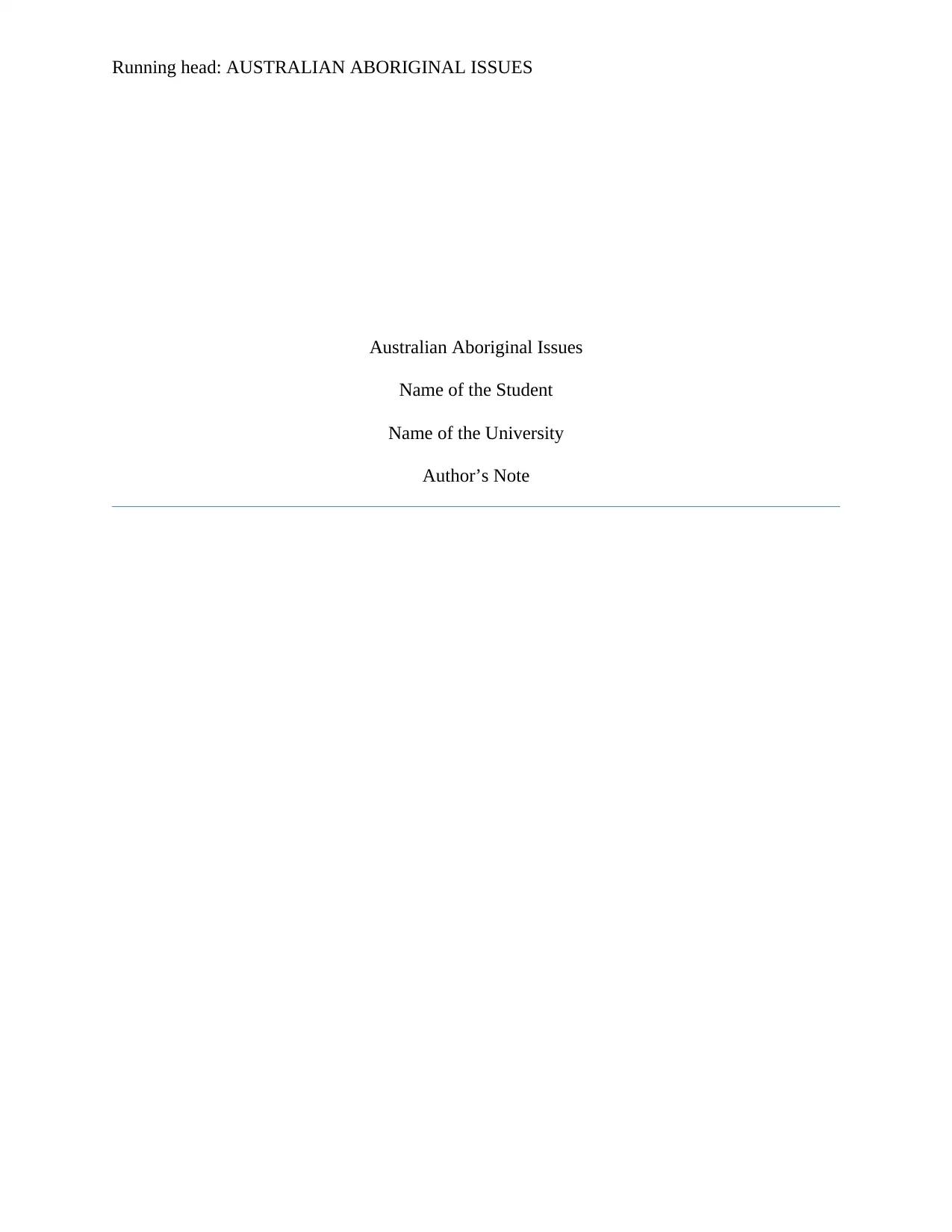
Running head: AUSTRALIAN ABORIGINAL ISSUES
Australian Aboriginal Issues
Name of the Student
Name of the University
Author’s Note
Australian Aboriginal Issues
Name of the Student
Name of the University
Author’s Note
Paraphrase This Document
Need a fresh take? Get an instant paraphrase of this document with our AI Paraphraser
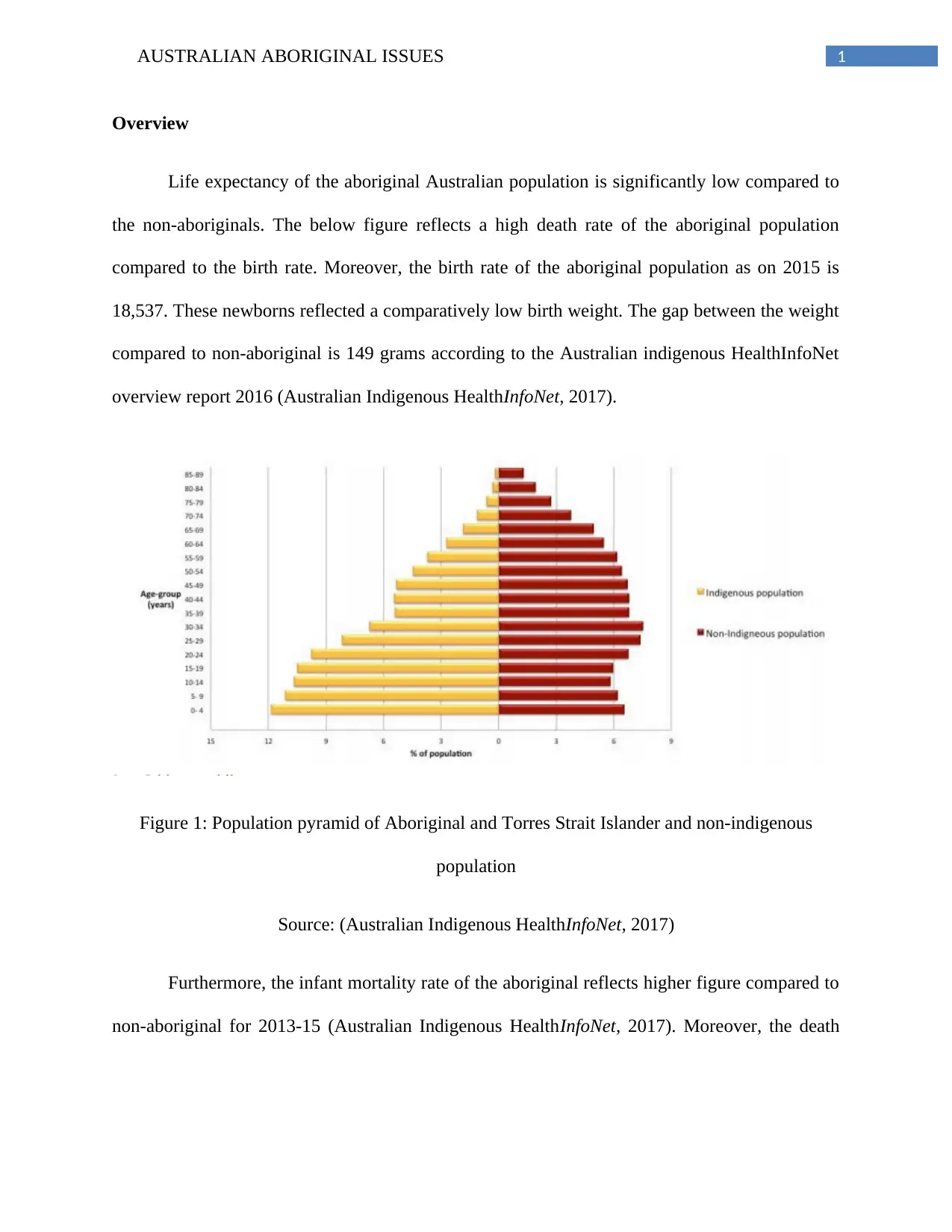
1AUSTRALIAN ABORIGINAL ISSUES
Overview
Life expectancy of the aboriginal Australian population is significantly low compared to
the non-aboriginals. The below figure reflects a high death rate of the aboriginal population
compared to the birth rate. Moreover, the birth rate of the aboriginal population as on 2015 is
18,537. These newborns reflected a comparatively low birth weight. The gap between the weight
compared to non-aboriginal is 149 grams according to the Australian indigenous HealthInfoNet
overview report 2016 (Australian Indigenous HealthInfoNet, 2017).
Figure 1: Population pyramid of Aboriginal and Torres Strait Islander and non-indigenous
population
Source: (Australian Indigenous HealthInfoNet, 2017)
Furthermore, the infant mortality rate of the aboriginal reflects higher figure compared to
non-aboriginal for 2013-15 (Australian Indigenous HealthInfoNet, 2017). Moreover, the death
Overview
Life expectancy of the aboriginal Australian population is significantly low compared to
the non-aboriginals. The below figure reflects a high death rate of the aboriginal population
compared to the birth rate. Moreover, the birth rate of the aboriginal population as on 2015 is
18,537. These newborns reflected a comparatively low birth weight. The gap between the weight
compared to non-aboriginal is 149 grams according to the Australian indigenous HealthInfoNet
overview report 2016 (Australian Indigenous HealthInfoNet, 2017).
Figure 1: Population pyramid of Aboriginal and Torres Strait Islander and non-indigenous
population
Source: (Australian Indigenous HealthInfoNet, 2017)
Furthermore, the infant mortality rate of the aboriginal reflects higher figure compared to
non-aboriginal for 2013-15 (Australian Indigenous HealthInfoNet, 2017). Moreover, the death
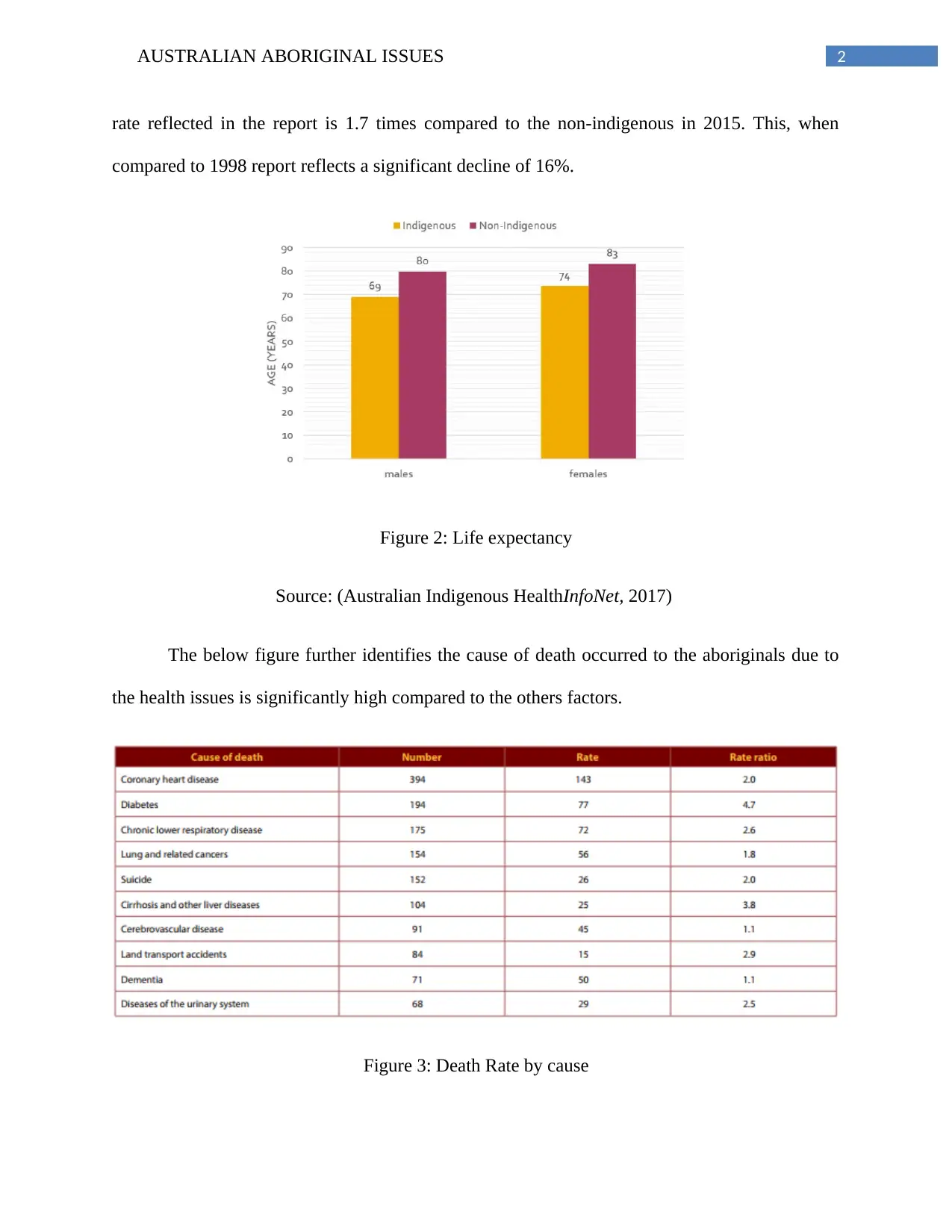
2AUSTRALIAN ABORIGINAL ISSUES
rate reflected in the report is 1.7 times compared to the non-indigenous in 2015. This, when
compared to 1998 report reflects a significant decline of 16%.
Figure 2: Life expectancy
Source: (Australian Indigenous HealthInfoNet, 2017)
The below figure further identifies the cause of death occurred to the aboriginals due to
the health issues is significantly high compared to the others factors.
Figure 3: Death Rate by cause
rate reflected in the report is 1.7 times compared to the non-indigenous in 2015. This, when
compared to 1998 report reflects a significant decline of 16%.
Figure 2: Life expectancy
Source: (Australian Indigenous HealthInfoNet, 2017)
The below figure further identifies the cause of death occurred to the aboriginals due to
the health issues is significantly high compared to the others factors.
Figure 3: Death Rate by cause
⊘ This is a preview!⊘
Do you want full access?
Subscribe today to unlock all pages.

Trusted by 1+ million students worldwide
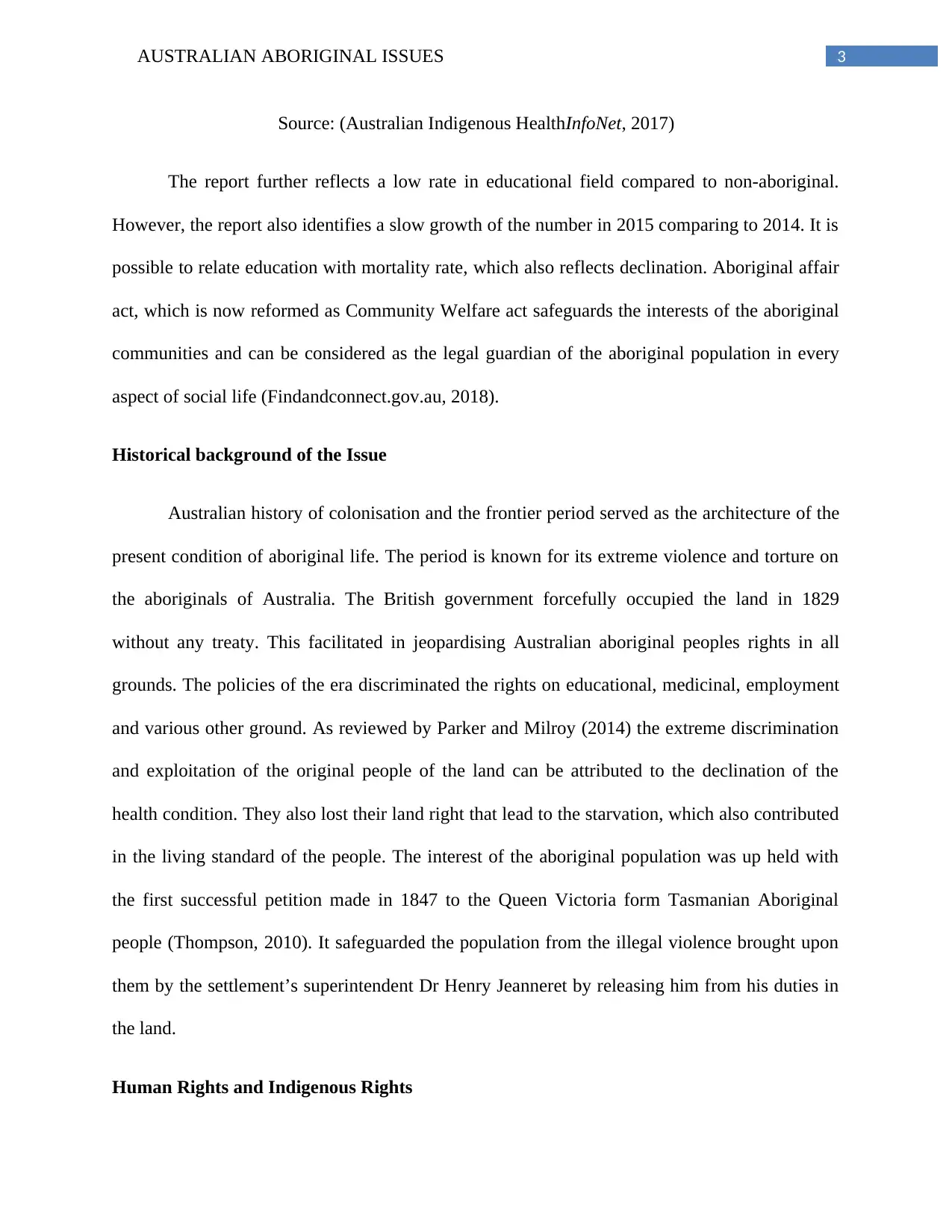
3AUSTRALIAN ABORIGINAL ISSUES
Source: (Australian Indigenous HealthInfoNet, 2017)
The report further reflects a low rate in educational field compared to non-aboriginal.
However, the report also identifies a slow growth of the number in 2015 comparing to 2014. It is
possible to relate education with mortality rate, which also reflects declination. Aboriginal affair
act, which is now reformed as Community Welfare act safeguards the interests of the aboriginal
communities and can be considered as the legal guardian of the aboriginal population in every
aspect of social life (Findandconnect.gov.au, 2018).
Historical background of the Issue
Australian history of colonisation and the frontier period served as the architecture of the
present condition of aboriginal life. The period is known for its extreme violence and torture on
the aboriginals of Australia. The British government forcefully occupied the land in 1829
without any treaty. This facilitated in jeopardising Australian aboriginal peoples rights in all
grounds. The policies of the era discriminated the rights on educational, medicinal, employment
and various other ground. As reviewed by Parker and Milroy (2014) the extreme discrimination
and exploitation of the original people of the land can be attributed to the declination of the
health condition. They also lost their land right that lead to the starvation, which also contributed
in the living standard of the people. The interest of the aboriginal population was up held with
the first successful petition made in 1847 to the Queen Victoria form Tasmanian Aboriginal
people (Thompson, 2010). It safeguarded the population from the illegal violence brought upon
them by the settlement’s superintendent Dr Henry Jeanneret by releasing him from his duties in
the land.
Human Rights and Indigenous Rights
Source: (Australian Indigenous HealthInfoNet, 2017)
The report further reflects a low rate in educational field compared to non-aboriginal.
However, the report also identifies a slow growth of the number in 2015 comparing to 2014. It is
possible to relate education with mortality rate, which also reflects declination. Aboriginal affair
act, which is now reformed as Community Welfare act safeguards the interests of the aboriginal
communities and can be considered as the legal guardian of the aboriginal population in every
aspect of social life (Findandconnect.gov.au, 2018).
Historical background of the Issue
Australian history of colonisation and the frontier period served as the architecture of the
present condition of aboriginal life. The period is known for its extreme violence and torture on
the aboriginals of Australia. The British government forcefully occupied the land in 1829
without any treaty. This facilitated in jeopardising Australian aboriginal peoples rights in all
grounds. The policies of the era discriminated the rights on educational, medicinal, employment
and various other ground. As reviewed by Parker and Milroy (2014) the extreme discrimination
and exploitation of the original people of the land can be attributed to the declination of the
health condition. They also lost their land right that lead to the starvation, which also contributed
in the living standard of the people. The interest of the aboriginal population was up held with
the first successful petition made in 1847 to the Queen Victoria form Tasmanian Aboriginal
people (Thompson, 2010). It safeguarded the population from the illegal violence brought upon
them by the settlement’s superintendent Dr Henry Jeanneret by releasing him from his duties in
the land.
Human Rights and Indigenous Rights
Paraphrase This Document
Need a fresh take? Get an instant paraphrase of this document with our AI Paraphraser
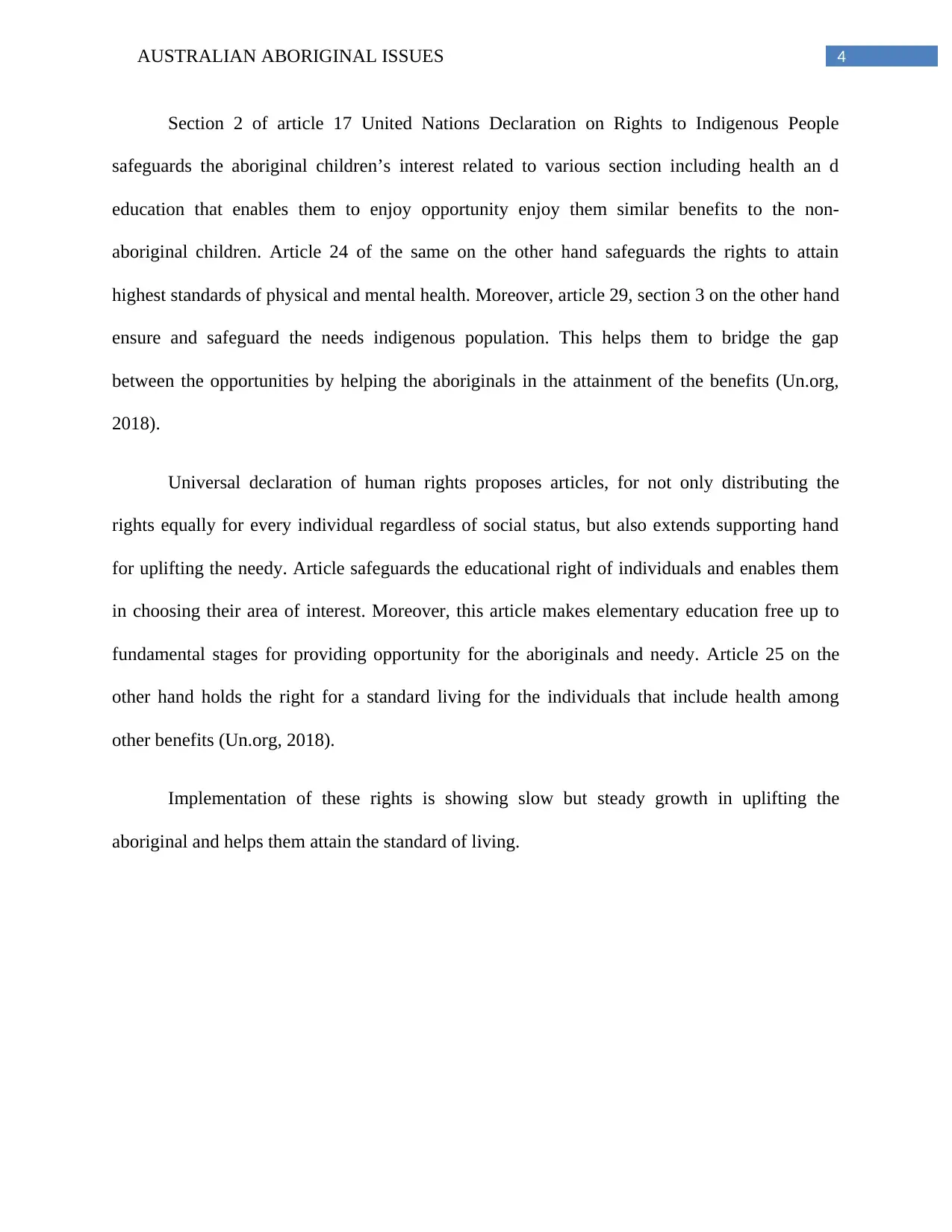
4AUSTRALIAN ABORIGINAL ISSUES
Section 2 of article 17 United Nations Declaration on Rights to Indigenous People
safeguards the aboriginal children’s interest related to various section including health an d
education that enables them to enjoy opportunity enjoy them similar benefits to the non-
aboriginal children. Article 24 of the same on the other hand safeguards the rights to attain
highest standards of physical and mental health. Moreover, article 29, section 3 on the other hand
ensure and safeguard the needs indigenous population. This helps them to bridge the gap
between the opportunities by helping the aboriginals in the attainment of the benefits (Un.org,
2018).
Universal declaration of human rights proposes articles, for not only distributing the
rights equally for every individual regardless of social status, but also extends supporting hand
for uplifting the needy. Article safeguards the educational right of individuals and enables them
in choosing their area of interest. Moreover, this article makes elementary education free up to
fundamental stages for providing opportunity for the aboriginals and needy. Article 25 on the
other hand holds the right for a standard living for the individuals that include health among
other benefits (Un.org, 2018).
Implementation of these rights is showing slow but steady growth in uplifting the
aboriginal and helps them attain the standard of living.
Section 2 of article 17 United Nations Declaration on Rights to Indigenous People
safeguards the aboriginal children’s interest related to various section including health an d
education that enables them to enjoy opportunity enjoy them similar benefits to the non-
aboriginal children. Article 24 of the same on the other hand safeguards the rights to attain
highest standards of physical and mental health. Moreover, article 29, section 3 on the other hand
ensure and safeguard the needs indigenous population. This helps them to bridge the gap
between the opportunities by helping the aboriginals in the attainment of the benefits (Un.org,
2018).
Universal declaration of human rights proposes articles, for not only distributing the
rights equally for every individual regardless of social status, but also extends supporting hand
for uplifting the needy. Article safeguards the educational right of individuals and enables them
in choosing their area of interest. Moreover, this article makes elementary education free up to
fundamental stages for providing opportunity for the aboriginals and needy. Article 25 on the
other hand holds the right for a standard living for the individuals that include health among
other benefits (Un.org, 2018).
Implementation of these rights is showing slow but steady growth in uplifting the
aboriginal and helps them attain the standard of living.
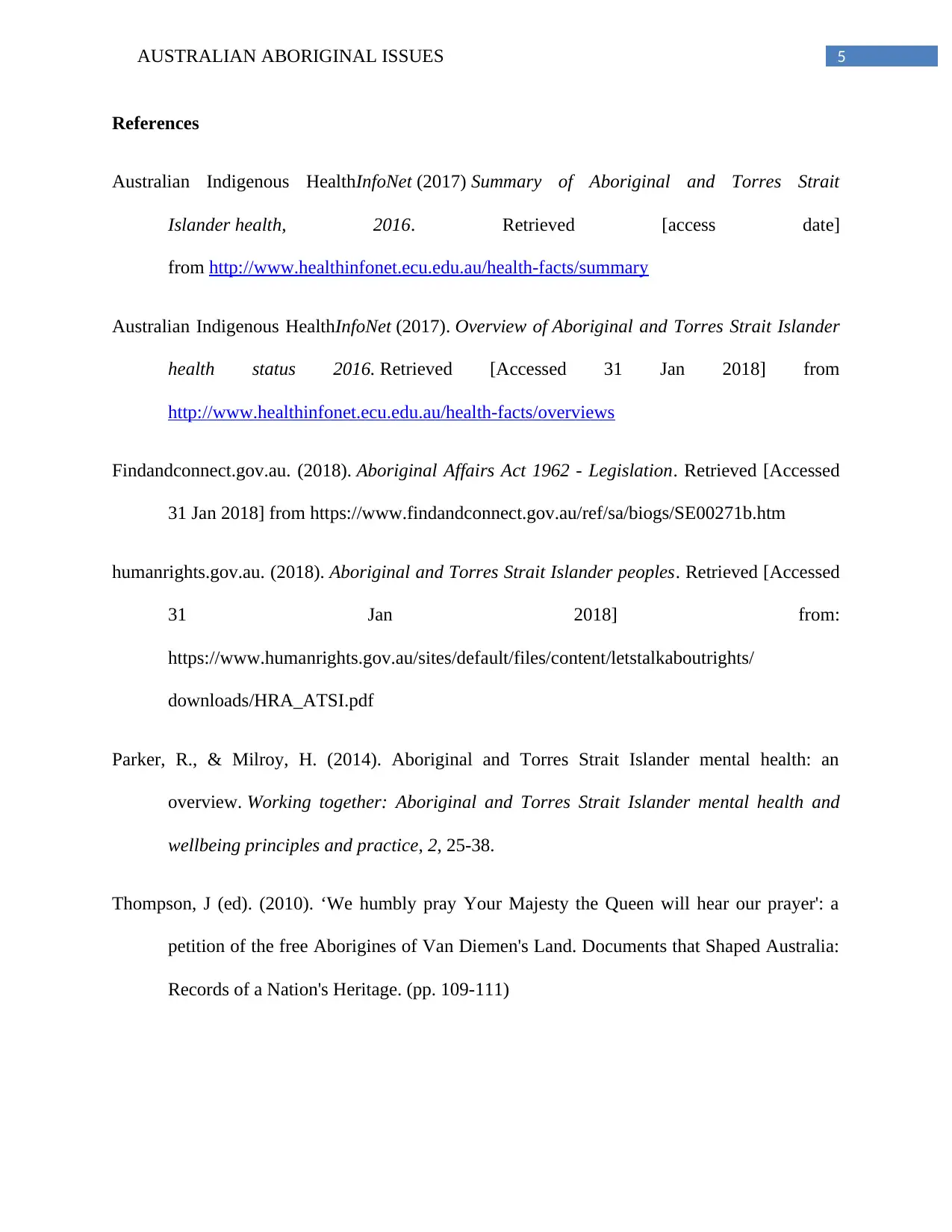
5AUSTRALIAN ABORIGINAL ISSUES
References
Australian Indigenous HealthInfoNet (2017) Summary of Aboriginal and Torres Strait
Islander health, 2016. Retrieved [access date]
from http://www.healthinfonet.ecu.edu.au/health-facts/summary
Australian Indigenous HealthInfoNet (2017). Overview of Aboriginal and Torres Strait Islander
health status 2016. Retrieved [Accessed 31 Jan 2018] from
http://www.healthinfonet.ecu.edu.au/health-facts/overviews
Findandconnect.gov.au. (2018). Aboriginal Affairs Act 1962 - Legislation. Retrieved [Accessed
31 Jan 2018] from https://www.findandconnect.gov.au/ref/sa/biogs/SE00271b.htm
humanrights.gov.au. (2018). Aboriginal and Torres Strait Islander peoples. Retrieved [Accessed
31 Jan 2018] from:
https://www.humanrights.gov.au/sites/default/files/content/letstalkaboutrights/
downloads/HRA_ATSI.pdf
Parker, R., & Milroy, H. (2014). Aboriginal and Torres Strait Islander mental health: an
overview. Working together: Aboriginal and Torres Strait Islander mental health and
wellbeing principles and practice, 2, 25-38.
Thompson, J (ed). (2010). ‘We humbly pray Your Majesty the Queen will hear our prayer': a
petition of the free Aborigines of Van Diemen's Land. Documents that Shaped Australia:
Records of a Nation's Heritage. (pp. 109-111)
References
Australian Indigenous HealthInfoNet (2017) Summary of Aboriginal and Torres Strait
Islander health, 2016. Retrieved [access date]
from http://www.healthinfonet.ecu.edu.au/health-facts/summary
Australian Indigenous HealthInfoNet (2017). Overview of Aboriginal and Torres Strait Islander
health status 2016. Retrieved [Accessed 31 Jan 2018] from
http://www.healthinfonet.ecu.edu.au/health-facts/overviews
Findandconnect.gov.au. (2018). Aboriginal Affairs Act 1962 - Legislation. Retrieved [Accessed
31 Jan 2018] from https://www.findandconnect.gov.au/ref/sa/biogs/SE00271b.htm
humanrights.gov.au. (2018). Aboriginal and Torres Strait Islander peoples. Retrieved [Accessed
31 Jan 2018] from:
https://www.humanrights.gov.au/sites/default/files/content/letstalkaboutrights/
downloads/HRA_ATSI.pdf
Parker, R., & Milroy, H. (2014). Aboriginal and Torres Strait Islander mental health: an
overview. Working together: Aboriginal and Torres Strait Islander mental health and
wellbeing principles and practice, 2, 25-38.
Thompson, J (ed). (2010). ‘We humbly pray Your Majesty the Queen will hear our prayer': a
petition of the free Aborigines of Van Diemen's Land. Documents that Shaped Australia:
Records of a Nation's Heritage. (pp. 109-111)
⊘ This is a preview!⊘
Do you want full access?
Subscribe today to unlock all pages.

Trusted by 1+ million students worldwide
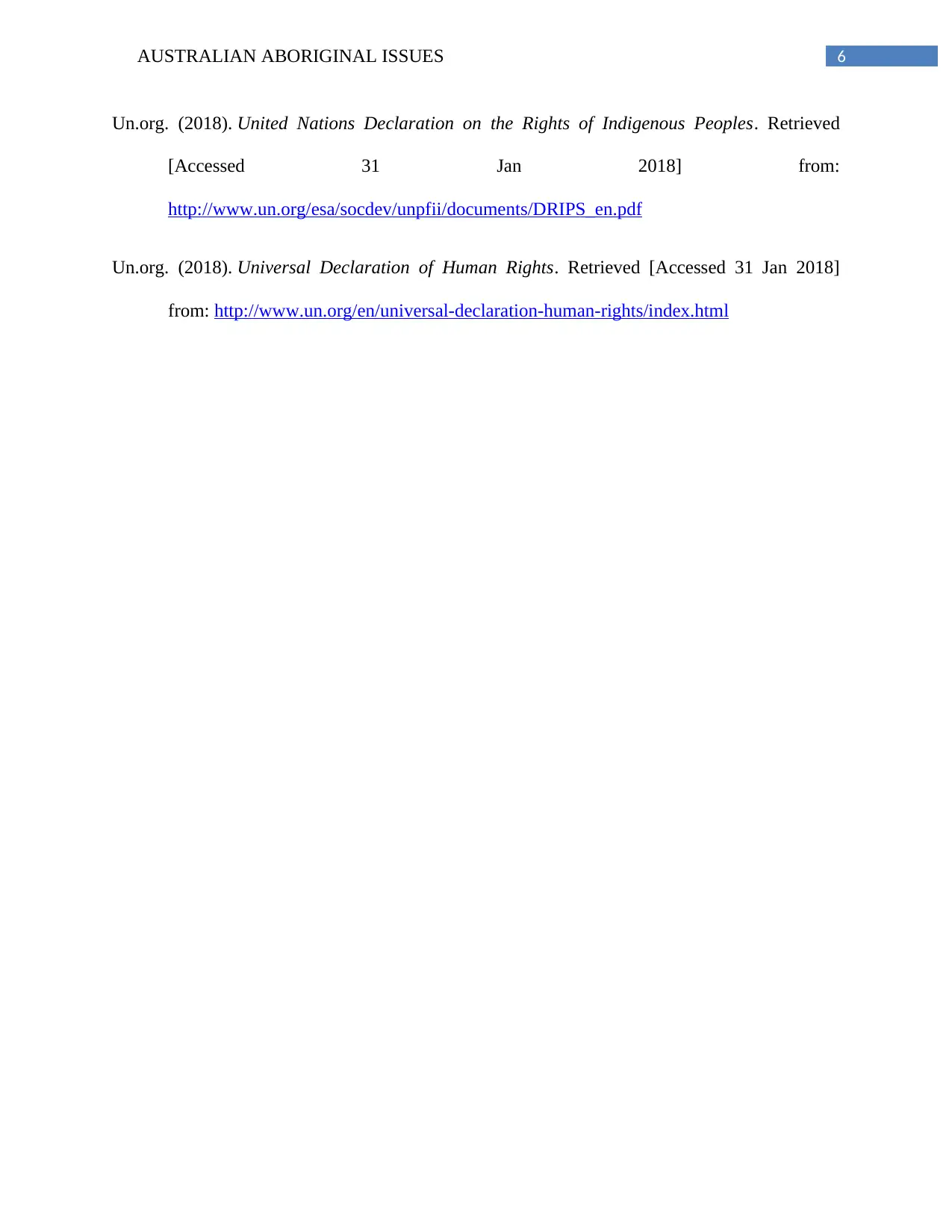
6AUSTRALIAN ABORIGINAL ISSUES
Un.org. (2018). United Nations Declaration on the Rights of Indigenous Peoples. Retrieved
[Accessed 31 Jan 2018] from:
http://www.un.org/esa/socdev/unpfii/documents/DRIPS_en.pdf
Un.org. (2018). Universal Declaration of Human Rights. Retrieved [Accessed 31 Jan 2018]
from: http://www.un.org/en/universal-declaration-human-rights/index.html
Un.org. (2018). United Nations Declaration on the Rights of Indigenous Peoples. Retrieved
[Accessed 31 Jan 2018] from:
http://www.un.org/esa/socdev/unpfii/documents/DRIPS_en.pdf
Un.org. (2018). Universal Declaration of Human Rights. Retrieved [Accessed 31 Jan 2018]
from: http://www.un.org/en/universal-declaration-human-rights/index.html
1 out of 7
Related Documents
Your All-in-One AI-Powered Toolkit for Academic Success.
+13062052269
info@desklib.com
Available 24*7 on WhatsApp / Email
![[object Object]](/_next/static/media/star-bottom.7253800d.svg)
Unlock your academic potential
Copyright © 2020–2025 A2Z Services. All Rights Reserved. Developed and managed by ZUCOL.





